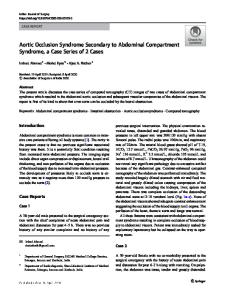Os odontoideum in wolcott-rallison syndrome: a case series of 4 patients
- PDF / 706,476 Bytes
- 5 Pages / 595.276 x 790.866 pts Page_size
- 49 Downloads / 274 Views
LETTER TO THE EDITOR
Open Access
Os odontoideum in wolcott-rallison syndrome: a case series of 4 patients R. P. Dias1, C. R. Buchanan2, N. Thomas3, S. Lim4, G. Solanki5, SEJ Connor6, T. G. Barrett1,7 and R. R. Kapoor2*
Abstract Wolcott-Rallison Syndrome is the commonest cause of neonatal diabetes in consanguineous families. It is associated with liver dysfunction, epiphyseal dysplasia, and developmental delay. It is caused by mutations in eukaryotic translation initiation factor 2-α kinase 3 (EIF2AK3). We report 4 children with WRS and Os Odontoideum resulting in significant neurological compromise. This cervical spine abnormality has not previously been described in this syndrome. This additional evidence broadens the clinical spectrum of this syndrome and confirms the role of EIF2AK3 in skeletal development. Furthermore, Os Odontoideum needs to be actively screened for in WRS patients to prevent neurological and respiratory compromise. Keywords: Neonatal Diabetes, Os Odontoideum, Wolcott-Rallison Syndrome, Atlanto-axial instability
Letter to the editor Wolcott-Rallison Syndrome (WRS; OMIM 226980) is a rare autosomal recessive disorder characterised by infancy onset insulin-dependent diabetes and multiple epiphyseal dyspasia [1]. It is caused by mutations in the gene encoding eukaryotic translation initiation factor 2α kinase 3 (EIF2AK3) which is located at Chromosome 2p12 [2]. EIF2AK3 acts as a stress sensor and, upon activation, phosphorylates EIF2alpha and regulates synthesis of unfolded proteins in the endoplasmic reticulum [3]. Other reported clinical features of WRS include recurrent episodes of severe (potentially fatal) hepatic dysfunction, renal impairment and developmental delay [4, 5]. The multiple epiphyseal dysplasia associated with WRS characteristically affects the long bones, pelvis and vertebrae. Osteoporosis has also been described in association with WRS in some patients [6]. We report four patients with WRS and Os odontoideum, a cervical spine abnormality not previously reported in associated with WRS. Os odontoideum is a condition where the odontoid peg is radiologically separated from the body of the second cervical vertebra although continuity with cartilagenous (unossified) tissues has not been clearly defined [7]. Two of the four patients * Correspondence: [email protected] 2 Department of Child Health, King’s College Hospital, London SE5 9RS, UK Full list of author information is available at the end of the article
had symptomatic atlanto-axial instability (AAI) requiring spinal fusion to relieve symptoms.
Case reports Patient 1
This female patient, now aged 21 years, presented with antibody negative (Islet Cell / Glutamic Acid decarboxylase) diabetes mellitus aged 6 months. Her parents are White British and unrelated. At 3 years of age, she developed acute liver failure, encephalopathy and renal dysfunction during a minor febrile illness. She recovered completely except for residual cerebellar signs (dysarthria, ataxia). Progressive growth failure developed from 3–4 years of ag
Data Loading...











